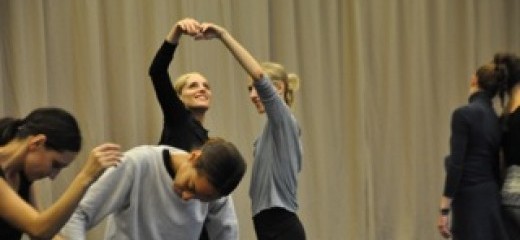
What makes a choreographic transmission successful?
Last July I was sharing a cup of coffee with thINKingDANCE co-founder and editor, Lisa Kraus, when she casually mentioned that she would be setting Trisha Brown’s “Glacial Decoy” on the Paris Opera Ballet this fall. My unabashed interest in Kraus’s re-staging prompted a generous invitation to join and observe her teach Brown’s work. With the briefest hesitation I leapt at her offer. How could I resist? Visions of the little rats of the Paris Opera1 began scurrying through my head. Paris, here I come!
During my glorious week in Paris I sat in on three rehearsal sessions that included Kraus, a former dancer with Trisha Brown Dance Company; Carolyn Lucas, Associate Artistic Director of Trisha Brown Company; POB rehearsal assistant, Fabrice Bourgeois and ten female dancers. To a dance geek like myself, I had achieved Nirvana.
An 18 minute-long quartet performed in silence, the demands of “Glacial Decoy” are great. With its quicksilver changes in weight, space, time and flow, precise spacing requirements and fractionalized placement of the body in space, it is a complex dance to learn, even for the best dancers — and a complex dance to teach, too. With that in mind, Kraus typically began rehearsals with an hour of movement exercises. The intention here was to ease the dancers out of their balletically organized bodies and into the unfamiliar movement Gestalt required in “Glacial Decoy.” Investigating how weight moved through joints and into the feet was a big focus. In one rehearsal, Kraus began by having the dancers explore energy and body sensation through a series of Qi Gong exercises. On another day, she had them play with passive and active weight through simple, paired contact improvisation exercises. These explorations seemed critical in helping the dancers tune into the energetic origins that would be fundamental to performing Brown’s choreography successfully. Without this attention to dynamics, “Glacial Decoy” would never transmit full movement value.
So, what makes a choreographic transmission successful? As I observed with Kraus, preparation seems crucial. To find out more, I spoke with two other experts in the field: Certified Movement Analyst, Susan Deutsch and Janet Pilla, a dancer who has re-staged several works by Jose Limón.
Deutsch and Pilla both confirmed what I observed in rehearsals; that focused exercises and imagery are useful ways to acclimate dancers to the desired nuances needed for a particular dance, as when the P.O.B. dancers were instructed to think of lightly brushing a bug off of their wrist in an arm gesture. Like gently stoking a fire, this kind of attention builds the most receptive environment for the dancers to ignite the movement from within. But another big component of success comes from the relationship of the teacher, or transmitter, to the work. Pilla is only allowed to restage Limón dances she has actually performed. This is a rule of the The Limón Foundation, guardian institution of Limón’s work. Deutsch brings up the dilemma of choreography being handed down from one generation of performers to the next. If care is not taken, the net result can be a kind of whispering down the lane where the original “message” has been diluted and distorted. Because Kraus and Lucas are veteran’s of Trisha Brown Dance Company and have both danced in “Glacial Decoy” – Kraus in its debut in 1979 and Lucas after she joined the company in 1984 – they bring insider knowledge to their process.
Kraus and Lucas’s relationship appeared egoless; they demonstrated great respect for one another’s input in their teaching collaboration. There was a poignant moment when Kraus was demonstrating a backward-moving pathway that Lucas asked to see repeated. Upon viewing it a second time, Lucas was ablaze with revelation and joy: “That’s what Trisha meant! That phrase makes so much sense now.” This instant showed such loving respect for Brown’s work that it was moving in itself. Because they each share a unique, first-person association with ”Glacial Decoy,” it’s easy to see how this will positively affect this rendering of the work. I am convinced that this is true for any choreography that is to be carried forward successfully.
It’s been three months since I was sitting on my porch with Lisa Kraus. As I sip my mug of hot coffee, infused with a bit of Parisian chocolate, on this fall day, I am a bit sad that I won’t be able to see the curtain rise on “Glacial Decoy.” But mon dieu, the glimpse I had was pretty damn fine.
1 This term refers to the students of the Paris Opera Ballet School.
Dancers in photo (L to R): Christelle Granier, Letizia Galloni, Caroline Bance, Severine Westermann, Laurence Laffon and Caroline Robert
By Lisa Bardarson
October 26, 2013










